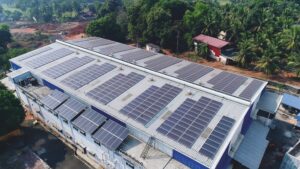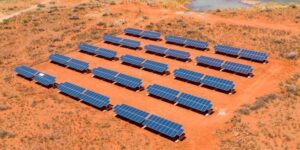In Africa, a combination of high energy costs and falling solar PV module prices is accelerating sales of solar directly to commercial and industrial customers. An estimated 74MW of installed capacity of grid solar for commercial and industrial use is recorded with an estimated 15 MW in Kenya, meaning the market is still small but has potential.
Commercial and industrial customers seek energy-efficient solutions to help access a stable supply of power to reduce it’s overall cost while sustainably integrating renewable solar energy. Customers energy demand profile is monitored over some time to inform the design of the energy solution, for example if to install energy hybrid (solar/Genset) and off-grid (storage) solar PV solutions to complement the grid supply or fossil fuel generator supply.
In multi-tenant commercial institutions such as office buildings and retail parks, load monitoring systems are designed to incentivize customers to shift demand to times when there is high solar energy capacity. While hybrid solar power supply systems achieve between 20 – 30% energy savings for commercial and industrial customers, there can also be an overhaul of grid electricity with off-grid solar power supply.

Worse enough, in Kenya, businesses experience up to four power outages in a month, totalling 24 hours of lost productivity, resulting in loss of an estimated 5.4% of their sales. This is why 66% of businesses own diesel-powered generators for back up. Off-grid solar provide cleaner and more reliable powering than such generators. Responsively, Total Kenya has solarized 107 service stations through the installation of 3,390 solar panels with 41 stations planned in 2021. The oil marketer joins a growing list of companies that have set up solar-powered stations for own use to slash power costs and stem unreliable grid power supply, a trend that has the impact of stirring the revenue stream of local electricity distributor.
The off-grid solar market is growing due to superior abilities to the grid-tied sources of electricity. Most importantly, off-grid systems can store renewably – generated electricity for use later, instead of requiring continuous consumption or selling-back in the “use it or lose it” scenario presented by simple grid-tied PV/solar schemes. Storage is the fulcrum over how renewable energy’s leverage will play out as it moves from a single to double-digit contribution to the total electricity mix. On one side of the balance are the utilities. For them, the ability to cost-effectively store renewably – generated electricity is critical since it is a variable, but continued inconsistent supply with which to meet steady-state power demand is worrying. Recent versions of off-grid solar systems possess operating modes that can “zero out” the grid, effectively keeping the customer/user off-grid whenever possible and drawing on the grid only to meet peak needs or charge batteries when renewable sources are insufficient.
As this market evolves, customer sensitization requires a step up. Potential customers’ limited understanding of the benefits of on-site solar is a limitation. In response, developers have offered initial financing for a short period to demonstrate to the customer that on-site solar is working before payment is due. If the C&I market was to develop rapidly, there is need to explore a more collective, effective and sustainable approach to customer awareness – this can be innovatively modelled into the financing instrument with clear milestones – may be repayment reliefs.
Also, net metering remains elusive. This means installations are designed so that all power generated can be consumed directly by the C&I customer. For now, this value proposition is still attractive for customers operating although the week, C&I solar sector is growing because of unit economics, and not regulatory support. In Kenya, local developers have estimated a pipeline of 26 MW projects which require affordable and patient financing. With an estimated Capex for a C&I solar installation ranging from US$0.70 – 1.40/W, the total value of immediate financing need stands at US$ 27.3 million (approximately (KES. 2.73 billion), an estimated 20 – 30% of which is demanded in local currency.

While high – cost outlay is required to actualize growing demand for solar power by commercial and industrial customers, the local financial sector remains largely absent from this market. Most businesses have bought large off-grid solar systems for cash without external financing. Where leasing deals or PPAs have been signed, it has been financed with developer equity with occasional small debt facilities from DFIs or other impact investors. Inadequate financing is the biggest obstacle to faster growth. Reasons for limited financing include unfavourable terms (lack of proven business model leads banks to charge high interest – within a 2 – 3 years tenure) and limited suitable financing structures (limited project financing allowing borrowing against cash flows or equipment). There is a need for patient, affordable and with longer investment tenure coupled with technical assistance and business development services. Along with other investors, Kenya Climate Ventures will continue to service this market with concessional capital and capacity enhancement services.
Overall, solarisation of commercial and industrial facilities is the correct path to achieve the United Nations’ sustainable development goal number seven which focuses on the provision of sustainable, affordable, reliable and modern energy for all.











